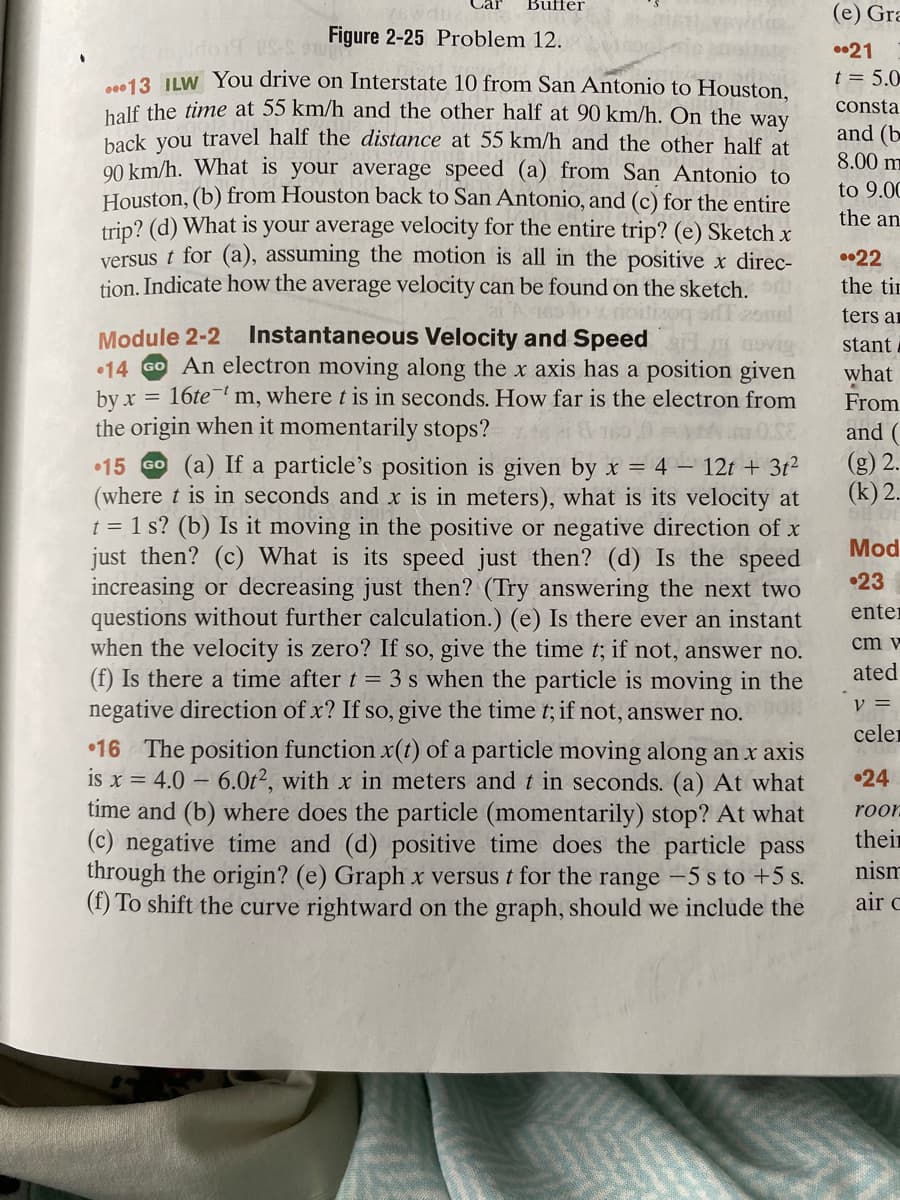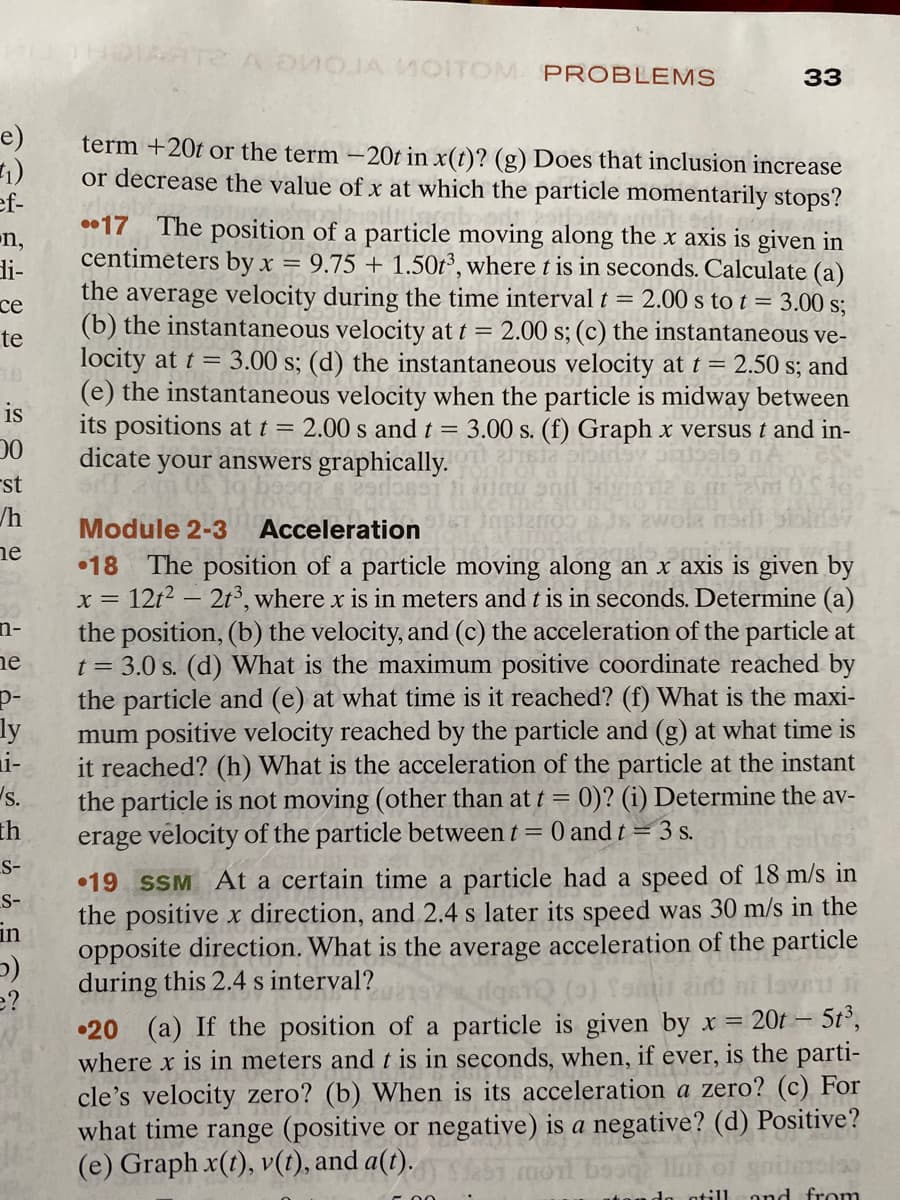...13 ILW You drive on Interstate 10 from San Antonio to Houston, half the time at 55 km/h and the other half at 90 km/h. On the way back you travel half the distance at 55 km/h and the other half at 90 km/h. What is your average speed (a) from San Antonio to Houston, (b) from Houston back to San Antonio, and (c) for the entire trip? (d) What is your average velocity for the entire trip? (e) Sketch x versus t for (a), assuming the motion is all in the positive x direc- tion. Indicate how the average velocity can be found on the sketch. ai A 165 to x rioitiag off Module 2-2 Instantaneous Velocity and Speed m 14 GO An electron moving along the x axis has a position given by x 16tem, where t is in seconds. How far is the electron from the origin when it momentarily stops? = GO 15 Go (a) If a particle's position is given by x = 4 - 12t + 3t² (where t is in seconds and x is in meters), what is its velocity at t = 1 s? (b) Is it moving in the positive or negative direction of x just then? (c) What is its speed just then? (d) Is the speed increasing or decreasing just then? (Try answering the next two questions without further calculation.) (e) Is there ever an instant when the velocity is zero? If so give the time t if not answer no •21 t = 5. const and C 8.00 to 9.0 the a 22 the t ters stan wha From and (g) (k) Mo 23 ent cm
...13 ILW You drive on Interstate 10 from San Antonio to Houston, half the time at 55 km/h and the other half at 90 km/h. On the way back you travel half the distance at 55 km/h and the other half at 90 km/h. What is your average speed (a) from San Antonio to Houston, (b) from Houston back to San Antonio, and (c) for the entire trip? (d) What is your average velocity for the entire trip? (e) Sketch x versus t for (a), assuming the motion is all in the positive x direc- tion. Indicate how the average velocity can be found on the sketch. ai A 165 to x rioitiag off Module 2-2 Instantaneous Velocity and Speed m 14 GO An electron moving along the x axis has a position given by x 16tem, where t is in seconds. How far is the electron from the origin when it momentarily stops? = GO 15 Go (a) If a particle's position is given by x = 4 - 12t + 3t² (where t is in seconds and x is in meters), what is its velocity at t = 1 s? (b) Is it moving in the positive or negative direction of x just then? (c) What is its speed just then? (d) Is the speed increasing or decreasing just then? (Try answering the next two questions without further calculation.) (e) Is there ever an instant when the velocity is zero? If so give the time t if not answer no •21 t = 5. const and C 8.00 to 9.0 the a 22 the t ters stan wha From and (g) (k) Mo 23 ent cm
Physics for Scientists and Engineers, Technology Update (No access codes included)
9th Edition
ISBN:9781305116399
Author:Raymond A. Serway, John W. Jewett
Publisher:Raymond A. Serway, John W. Jewett
Chapter2: Motion In One Dimension
Section: Chapter Questions
Problem 2.11P: A hare and a tortoise compete in a race over a straight course 1.00 km long. The tortoise crawls at...
Related questions
Question
Number 16 part a b c d e f and g can you show all work

Transcribed Image Text:Car
Buffer
Figure 2-25 Problem 12.
TE maldorf US-S
...13 ILW You drive on Interstate 10 from San Antonio to Houston,
half the time at 55 km/h and the other half at 90 km/h. On the way
back you travel half the distance at 55 km/h and the other half at
90 km/h. What is your average speed (a) from San Antonio to
Houston, (b) from Houston back to San Antonio, and (c) for the entire
trip? (d) What is your average velocity for the entire trip? (e) Sketch x
versus t for (a), assuming the motion is all in the positive x direc-
tion. Indicate how the average velocity can be found on the sketch.
165 to x rioitizoq s
Module 2-2 Instantaneous Velocity and Speed
F
14 GO An electron moving along the x axis has a position given
by x =
= 16tem, where t is in seconds. How far is the electron from
the origin when it momentarily stops?
15 Go (a) If a particle's position is given by x = 4 - 12t + 3t²
(where t is in seconds and x is in meters), what is its velocity at
t = 1 s? (b) Is it moving in the positive or negative direction of x
just then? (c) What is its speed just then? (d) Is the speed
increasing or decreasing just then? (Try answering the next two
questions without further calculation.) (e) Is there ever an instant
when the velocity is zero? If so, give the time t; if not, answer no.
(f) Is there a time after t = 3 s when the particle is moving in the
negative direction of x? If so, give the time t; if not, answer no.
16 The position function x(t) of a particle moving along an x axis
is x = 4.0-6.0t2, with x in meters and t in seconds. (a) At what
time and (b) where does the particle (momentarily) stop? At what
(c) negative time and (d) positive time does the particle pass
through the origin? (e) Graph x versus t for the range -5 s to +5 s.
(f) To shift the curve rightward on the graph, should we include the
(e) Gra
21
t = 5.0
consta
and (b
8.00 m
to 9.00
the an
22
the tim
ters ar
stant
what
From
and (
(g) 2
(k) 2.
Mod
•23
enter
cm v
ated
V =
celer
•24
roor
their
nism
air C

Transcribed Image Text:e)
(1)
ef-
n,
di-
ce
te
is
00
st
/h
ne
n-
e
p-
ly
i-
s.
th
S-
S-
in
5)
e?
ARTE A DVOJA MOITOM PROBLEMS
term +20t or the term -20t in x(t)? (g) Does that inclusion increase
or decrease the value of x at which the particle momentarily stops?
33
17 The position of a particle moving along the x axis is given in
centimeters by x = 9.75 +1.50t³, where t is in seconds. Calculate (a)
the average velocity during the time interval t = 2.00 s to t = 3.00 s;
(b) the instantaneous velocity at t = 2.00 s; (c) the instantaneous ve-
locity at t = 3.00 s; (d) the instantaneous velocity at t = 2.50 s; and
(e) the instantaneous velocity when the particle is midway between
its positions at t = 2.00 s and t = 3.00 s. (f) Graph x versus t and in-
dicate your answers graphically.
9167
Module 2-3
Acceleration
00 8JS 2wola nodi
18 The position of a particle moving along an x axis is given by
x = 12t² - 2t³, where x is in meters and t is in seconds. Determine (a)
the position, (b) the velocity, and (c) the acceleration of the particle at
t = 3.0 s. (d) What is the maximum positive coordinate reached by
the particle and (e) at what time is it reached? (f) What is the maxi-
mum positive velocity reached by the particle and (g) at what time is
it reached? (h) What is the acceleration of the particle at the instant
the particle is not moving (other than at t = 0)? (i) Determine the av-
erage velocity of the particle between t = 0 and t = 3 s.
19 SSM At a certain time a particle had a speed of 18 m/s in
the positive x direction, and 2.4 s later its speed was 30 m/s in the
opposite direction. What is the average acceleration of the particle
during this 2.4 s interval?
dast
Tamil
20 (a) If the position of a particle is given by x = 20t - 5t³,
where x is in meters and t is in seconds, when, if ever, is the parti-
cle's velocity zero? (b) When is its acceleration a zero? (c) For
what time range (positive or negative) is a negative? (d) Positive?
(e) Graph x(t), v(t), and a(t).
negative d
abi moi
bona lo
00
tando otill and from
Expert Solution
This question has been solved!
Explore an expertly crafted, step-by-step solution for a thorough understanding of key concepts.
Step by step
Solved in 3 steps with 3 images

Knowledge Booster
Learn more about
Need a deep-dive on the concept behind this application? Look no further. Learn more about this topic, physics and related others by exploring similar questions and additional content below.Recommended textbooks for you

Physics for Scientists and Engineers, Technology …
Physics
ISBN:
9781305116399
Author:
Raymond A. Serway, John W. Jewett
Publisher:
Cengage Learning

College Physics
Physics
ISBN:
9781285737027
Author:
Raymond A. Serway, Chris Vuille
Publisher:
Cengage Learning

College Physics
Physics
ISBN:
9781305952300
Author:
Raymond A. Serway, Chris Vuille
Publisher:
Cengage Learning

Physics for Scientists and Engineers, Technology …
Physics
ISBN:
9781305116399
Author:
Raymond A. Serway, John W. Jewett
Publisher:
Cengage Learning

College Physics
Physics
ISBN:
9781285737027
Author:
Raymond A. Serway, Chris Vuille
Publisher:
Cengage Learning

College Physics
Physics
ISBN:
9781305952300
Author:
Raymond A. Serway, Chris Vuille
Publisher:
Cengage Learning

Physics for Scientists and Engineers
Physics
ISBN:
9781337553278
Author:
Raymond A. Serway, John W. Jewett
Publisher:
Cengage Learning

Principles of Physics: A Calculus-Based Text
Physics
ISBN:
9781133104261
Author:
Raymond A. Serway, John W. Jewett
Publisher:
Cengage Learning

Physics for Scientists and Engineers with Modern …
Physics
ISBN:
9781337553292
Author:
Raymond A. Serway, John W. Jewett
Publisher:
Cengage Learning